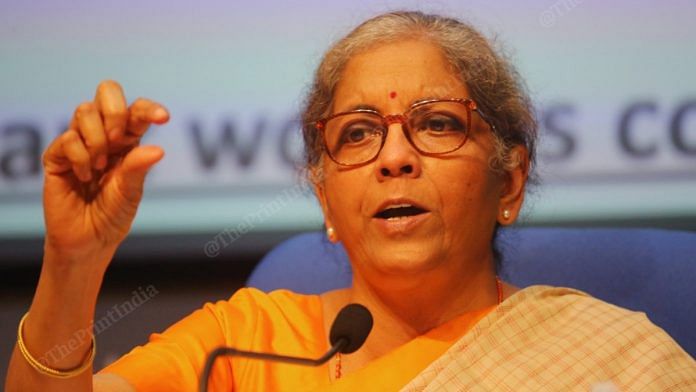
New Delhi: Two days before Diwali, the Narendra Modi government Thursday announced a slew of stimulus measures to generate employment and provide liquidity support to stressed sectors such as tourism, aviation and construction, and boost the housing market.
These measures are aimed at supporting an Indian economy headed towards a recession, and sustaining the nascent growth recovery seen in October.
In a press conference Thursday, Finance Minister Nirmala Sitharaman said India is seeing “strong economic recovery”, while also announcing a mix of wage support and additional budget allocations for job creation, and to support the rural and urban economy.
The measures announced Thursday are worth Rs 2.65 lakh crore, inclusive of the Rs 1.45 lakh crore production-linked incentive scheme announced the previous day. The overall cost of the measures announced by the government since the Covid-19 pandemic hit India is now nearly Rs 30 lakh crore, or 15 per cent of the GDP.
Of these, the support measures by the government account for 9 per cent of the GDP, Sitharaman said.
The Indian economy is expected to contract by double digits in 2020-21, due to the pandemic and the consequent lockdown, which brought economic activity to a halt.
Measures to boost employment
Sitharaman announced a new scheme — Atmanirbhar Bharat Rozgar Yojana — aimed at generating employment in the formal sector.
The government will provide subsidy to those firms registered with the Employees’ Provident Fund Organisation (EPFO) for all new employees hired between 30 September 2020 and 30 June 2021, whose wages are less than Rs 15,000.
The subsidy will be provided for two years, and will cost the government Rs 4,500 crore.
The government will provide a 12 per cent employee EPFO contribution and a 12 per cent employer contribution for those firms having less than 1,000 employees. These firms account for 99 per cent of all firms.
Firms having more than 1,000 employees will get only 12 per cent employee contribution.
Sitharaman also announced an additional Rs 10,000-crore allocation for the PM Garib Kalyan Rojgar Abhiyaan to boost rural employment and the rural economy.
Housing
The Modi government also more than tripled the allocation for the Pradhan Mantri Awas Yojana, aimed at boosting the housing sector.
From an initial allocation of Rs 8,000 crore for the scheme, the government has increased the allocation to Rs 26,000 crore this fiscal. This will create 78 lakh additional jobs and increase demand for cement and steel, Sitharaman said.
The government also relaxed an income tax provision that will enable developers to reduce property rates by up to 20 per cent compared to existing circle rates. This will help the middle class to buy houses, reduce hardships faced by both home buyers and developers, and help in clearing the unsold inventory, Sitharaman said.
Stressed sectors
The government extended the Rs 3 lakh crore emergency credit line guarantee scheme till 31 March 2021. So far, Rs 2.05 lakh crore has been sanctioned under this window.
It also extended the scope of this scheme to include firms in the 26 stressed sectors, identified by the RBI-constituted K.V. Kamath committee.
Through this scheme, firms having outstanding credit of Rs 50 crore to Rs 500 crore can get access to guaranteed collateral-free credit. The loans will have a one-year moratorium on principal repayment and another year for repayment.
Infrastructure boost
The government announced an additional capital outlay of Rs 10,200 crore for domestic defence equipment and industrial infrastructure.
In addition, it will infuse Rs 6,000 crore as equity in the National Investment and Infrastructure Fund’s debt platform, as India readies a massive Rs 111 lakh crore infrastructure pipeline.
Agriculture
The government increased the budget allocation to fertiliser subsidy by Rs 65,000 crore, taking the total fertiliser subsidy this fiscal to more than Rs 1.3 lakh crore.
This has been done taking into account record sowing levels, as well as the increased fertiliser use pattern seen in the current fiscal.
Subscribe to our channels on YouTube & Telegram
Why news media is in crisis & How you can fix it
India needs free, fair, non-hyphenated and questioning journalism even more as it faces multiple crises.
But the news media is in a crisis of its own. There have been brutal layoffs and pay-cuts. The best of journalism is shrinking, yielding to crude prime-time spectacle.
ThePrint has the finest young reporters, columnists and editors working for it. Sustaining journalism of this quality needs smart and thinking people like you to pay for it. Whether you live in India or overseas, you can do it here.